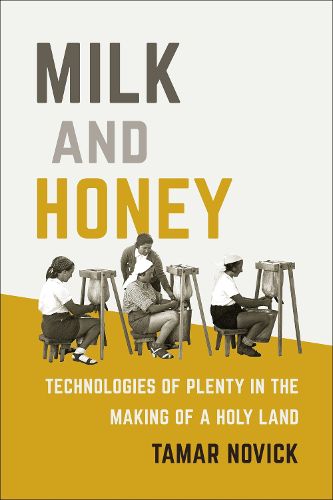Readings Newsletter
Become a Readings Member to make your shopping experience even easier.
Sign in or sign up for free!
You’re not far away from qualifying for FREE standard shipping within Australia
You’ve qualified for FREE standard shipping within Australia
The cart is loading…






An innovative historical analysis of the intersection of religion and technology in making the modern state, focusing on bodily production and reproduction across the human-animal divide.
An innovative historical analysis of the intersection of religion and technology in making the modern state, focusing on bodily production and reproduction across the human-animal divide.
In Milk and Honey, Tamar Novick writes a revolutionary environmental history of the state that centers on the intersection of technology and religion in modern Israel/Palestine. Focusing on animals and the management of their production and reproduction across three political regimes-the late-Ottoman rule, British rule, and the early Israeli state-Novick draws attention to the ways in which settlers and state experts used agricultural technology to recreate a biblical idea of past plenitude, literally a "land flowing with milk and honey," through the bodies of animals and people.
Novick presents a series of case studies involving the management of water buffalo, bees, goats, sheep, cows, and peoplein Palestine/Israel. She traces the intimate forms of knowledge and bodily labor-production and reproduction-in which this process took place, and the intertwining of bodily, political, and environmental realms in the transformation of Palestine/Israel. Her wide-ranging approach shows technology never replaced religion as a colonial device. Rather, it merged with settler-colonial aspirations to salvage the land, bolstering the effort to seize control over territory and people.
Fusing technology, religious fervor, bodily labor, and political ecology, Milk and Honey provides a novel account of the practices that defined and continue to shape settler-colonialism in the Palestine/Israel, revealing the ongoing entanglement of technoscience and religion in our time.
$9.00 standard shipping within Australia
FREE standard shipping within Australia for orders over $100.00
Express & International shipping calculated at checkout
An innovative historical analysis of the intersection of religion and technology in making the modern state, focusing on bodily production and reproduction across the human-animal divide.
An innovative historical analysis of the intersection of religion and technology in making the modern state, focusing on bodily production and reproduction across the human-animal divide.
In Milk and Honey, Tamar Novick writes a revolutionary environmental history of the state that centers on the intersection of technology and religion in modern Israel/Palestine. Focusing on animals and the management of their production and reproduction across three political regimes-the late-Ottoman rule, British rule, and the early Israeli state-Novick draws attention to the ways in which settlers and state experts used agricultural technology to recreate a biblical idea of past plenitude, literally a "land flowing with milk and honey," through the bodies of animals and people.
Novick presents a series of case studies involving the management of water buffalo, bees, goats, sheep, cows, and peoplein Palestine/Israel. She traces the intimate forms of knowledge and bodily labor-production and reproduction-in which this process took place, and the intertwining of bodily, political, and environmental realms in the transformation of Palestine/Israel. Her wide-ranging approach shows technology never replaced religion as a colonial device. Rather, it merged with settler-colonial aspirations to salvage the land, bolstering the effort to seize control over territory and people.
Fusing technology, religious fervor, bodily labor, and political ecology, Milk and Honey provides a novel account of the practices that defined and continue to shape settler-colonialism in the Palestine/Israel, revealing the ongoing entanglement of technoscience and religion in our time.